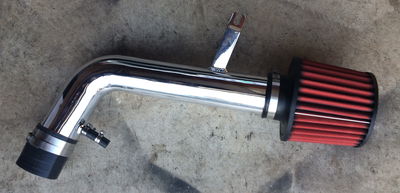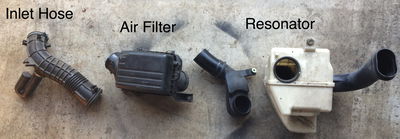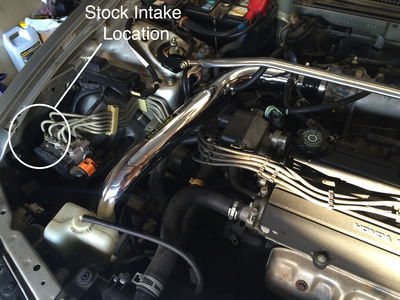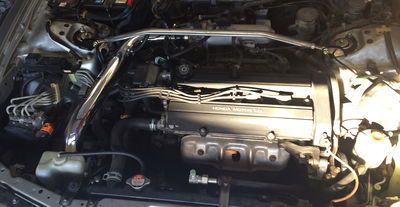Engineering Explained: Cold Air Intakes Vs Short Ram Intakes


Before getting into testing out these common aftermarket upgrades, it’s best to understand what each of these performance upgrades is attempting to achieve. Cold air intakes and short ram intakes both have the same goal, which is to increase horsepower. But they go about it in different ways.
Short ram intakes (SRI) look to increase power by reducing the amount of restriction on the intake air. In many vehicles, the intake air passes through a resonator and silencer box to help reduce induction noise. This restriction can limit airflow. A short ram eliminates the resonator and filter box, giving the air a short travel distance and hopefully increasing power. That said, it’s pulling air from the engine bay, thus the intake air will be warmer than by using a cold air intake.

Cold air intakes (CAI) look to increase power by moving the location which the engine pulls in air from inside the engine bay, to outside the engine bay. Many vehicles do this already, so you can see why it may seem a bit silly to shell out some money on this upgrade. Air outside of the engine bay is cooler, thus denser and carrying more oxygen, so it will allow the engine to burn more fuel and produce more power. That’s the theory, at least.

So, do either of these items work? Let’s check out the short ram first.
Below is a quick summary of the results. The acceleration tests are split into 1000rpm sections. For example, 2k-3k is the amount of time it takes for the vehicle to accelerate from 2000 to 3000rpm in the noted gear. As you can see, there were negligible gains at low rpm, a near three per cent decrease in mid rpm acceleration, and a 2.4-3.3 per cent improvement in high rpm acceleration.
| SRI: Second Gear, Wide Open Throttle | ||||
| 2k-3k | 3k-4k | 4k-5k | 5k-6k | |
| Stock (s) | 1.331 | 1.292 | 1.164 | 1.192 |
| SRI (s) | 1.322 | 1.331 | 1.136 | 1.153 |
| % Diff | 0.63% | -2.97% | 2.42% | 3.32% |
Considering the SRI pulled air from the engine bay and still saw some performance gains, perhaps the CAI will perform better.
Looking at the results, low rpm suffered while anything over 3000rpm appeared to have better acceleration, up to 4.64 per cent from 4000rpm to 5000rpm.
| CAI: Second Gear, Wide Open Throttle | ||||
| 2k-3k | 3k-4k | 4k-5k | 5k-6k | |
| Stock (s) | 1.331 | 1.292 | 1.164 | 1.192 |
| CAI (s) | 1.361 | 1.275 | 1.111 | 1.156 |
| % Diff | -2.27% | 1.3% | 4.64% | 3.08% |
Now that we have the results of both, is one better than the other?
Below 3000rpm the CAI is worse than the SRI, though it’s significantly better from 3000-5000rpm, where it then tapers off and the difference is negligible after 5000rpm.
| CAI vs SRI: Second Gear, WOT | ||||
| 2k-3k | 3k-4k | 4k-5k | 5k-6k | |
| SRI (s) | 1.322 | 1.331 | 1.136 | 1.153 |
| CAI (s) | 1.361 | 1.275 | 1.111 | 1.156 |
| % Diff | -2.9% | 4.26% | 2.22% | -0.24% |
So, let’s sum everything up and talk about why you might want each possible option.
- Stock: Best performance at low rpm, which is where your engine will spend most of its time if it’s a daily driver. If you don’t want increased induction noise, this option will offer the quietest ride. This is recommended for those who use their car as a daily driver and want the greatest low-end power which is ideal for city driving.
- SRI: Adds some benefit over the stock system, but only at high rpm. This also increases induction noise. Power seems to taper as the engine bay heats up. This is a budget-friendly option for cars which frequently visit the track, and also reduces the risk of pulling in water via the filter versus a CAI.
- CAI: For overall performance, this is the best option when the engine is revved to higher rpm. Induction noise is increased. A downside is that the location of the filter could potentially hydrolock the engine by pulling in water, as it is often located close to the ground. This is recommended for track or drag vehicles which keep the engine revs at higher rpm.

Plenty of people have asked why I performed this test since Mighty Car Mods already did. Well, the tests are actually quite different, and both provide valuable information. Here’s what I did differently:
- Analysed segments of the rev range: I broke down the acceleration differences throughout the rev range to see where it had an impact.
- Real-world airflow: It’s challenging to duplicate real-world airflow with an electric fan, so my acceleration runs were performed outside, rather than on a dyno. This should not take away any credibility of a dyno; they’re fantastic instruments for getting an understanding of how the power band has changed.
- Acceleration vs power: My tests determined real-world acceleration gains, as a percentage of how much faster the car accelerated at various rpm intervals.
- Every car is different: Test results will vary from vehicle to vehicle, so this provided a new perspective and insight on a different car.
Check out Engineering Explained’s previous articles:
- The pros and cons of different engine types.
- The pros and cons of superchargers vs turbochargers.
- Inline 5, V10, and rotary engines.














Comments
No comments found.